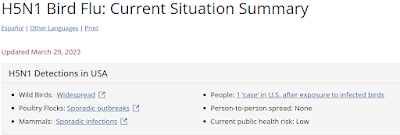
#17,382
Three days ago in Chile: MOH Reports Their 1st Human H5N1 Infection, we saw the official confirmation of the 2nd confirmed spillover of HPAI H5N1 into a human in South America (for the 1st, see January 11th's Ecuador MOH Confirms Human Infection with HPAI H5).Although only 11 human infections from H5N1 have been identified over the past 14 months, surveillance and testing is often less robust than we might desire, and some countries have been slow or reluctant to report cases (see Flying Blind In The Viral Storm).
As we saw three weeks ago, in J. Trvl. Med. Research Letter: First Case of Human Infection with HPAI H5 Influenza A Virus in South America, the Ecuadorian case was very nearly missed, with that patient having spent a full week in the hospital before PCR testing was undertaken, and a novel H5 flu was identified.
The reality is - to be picked up by surveillance - a patient must (generally) be sick enough to be hospitalized, and then lucky enough to have access to a well equipped medical facility; one that can do the requisite tests to identify a novel flu infection.
Making it likely that some H5N1 infections have gone undetected (or unreported) around the globe.
From the CDC's statement (below) we learn that samples are being sent to the CDC lab for further analysis, and that the patient's potential exposure is still under investigation. As the CDC has warned for the past year, with the virus spreading so widely in the environment, additional sporadic human infections are to be expected.
I'll have a bit more after the break.
Chile Reports First Case of H5N1
Updated March 30, 2023
The Ministry of Health in the South American nation of Chile has reported that country’s first case of human infection with avian influenza A(H5N1) virus. This is the second human “H5N1 bird flu” virus infection reported in South America, the first was reported by Ecuador in December and was associated with exposure to backyard poultry. In February of this year, neighboring Peru reported H5N1 virus infections in sea lions and pelicans after die-offs in those animals.
Globally, this is the 11th human case of H5N1 reported since January 2022. The prior 10 H5N1 cases all had exposure to poultry. The source of H5N1 virus infection for the patient in Chile is part of an ongoing investigation. A respiratory specimen from the Chile case-patient is being sent to CDC for confirmation and additional testing. In the U.S., one H5N1 case was reported in person who reported fatigue without any other symptoms after poultry culling activities.
As of March 10, 2023, H5N1 viruses (clade 2.3.4.4b) have been detected in wild birds or poultry in 16 countries in Latin America and the Caribbean as well as the United States and Canada, and in most of the rest of the world.
Detection of a human infection with H5N1 bird flu in another country in South America is not surprising. As noted in a recent CDC H5N1 technical report: “because of …the wide global prevalence of HPAI A(H5N1) viruses in wild birds and poultry outbreaks, continued sporadic human infections are anticipated.”
Further, the report notes that “To date, HPAI A(H5N1) viruses currently circulating in birds and poultry, with spillover to mammals, and those that have caused human infections do not have the ability to easily bind to receptors that predominate in the human upper respiratory tract. Therefore, the current risk to the public from HPAI A(H5N1) viruses remains low. However, continued comprehensive surveillance of these viruses in wild birds, poultry, mammals, and people worldwide, and frequent reassessments are critical to determine the public health risk, along with ongoing preparedness efforts.”
CDC is actively working on the H5 situation both internationally and domestically, including conducting surveillance in the U.S. among people with relevant exposures and preparing for the possibility that H5N1 viruses gain the ability to more easily spread to and between people. More information about H5 bird flu is available at:
But what happened before 1890s is pretty much a mystery, and there can always be a first time.
Add in the fact that H5N1 isn't the only zoonotic novel flu virus we are tracking (others include H5N6, H3N8, H9N2, and EA H1N1), and it is easy to see why even widely scattered, sporadic cases, are worthy of our continued attention.
